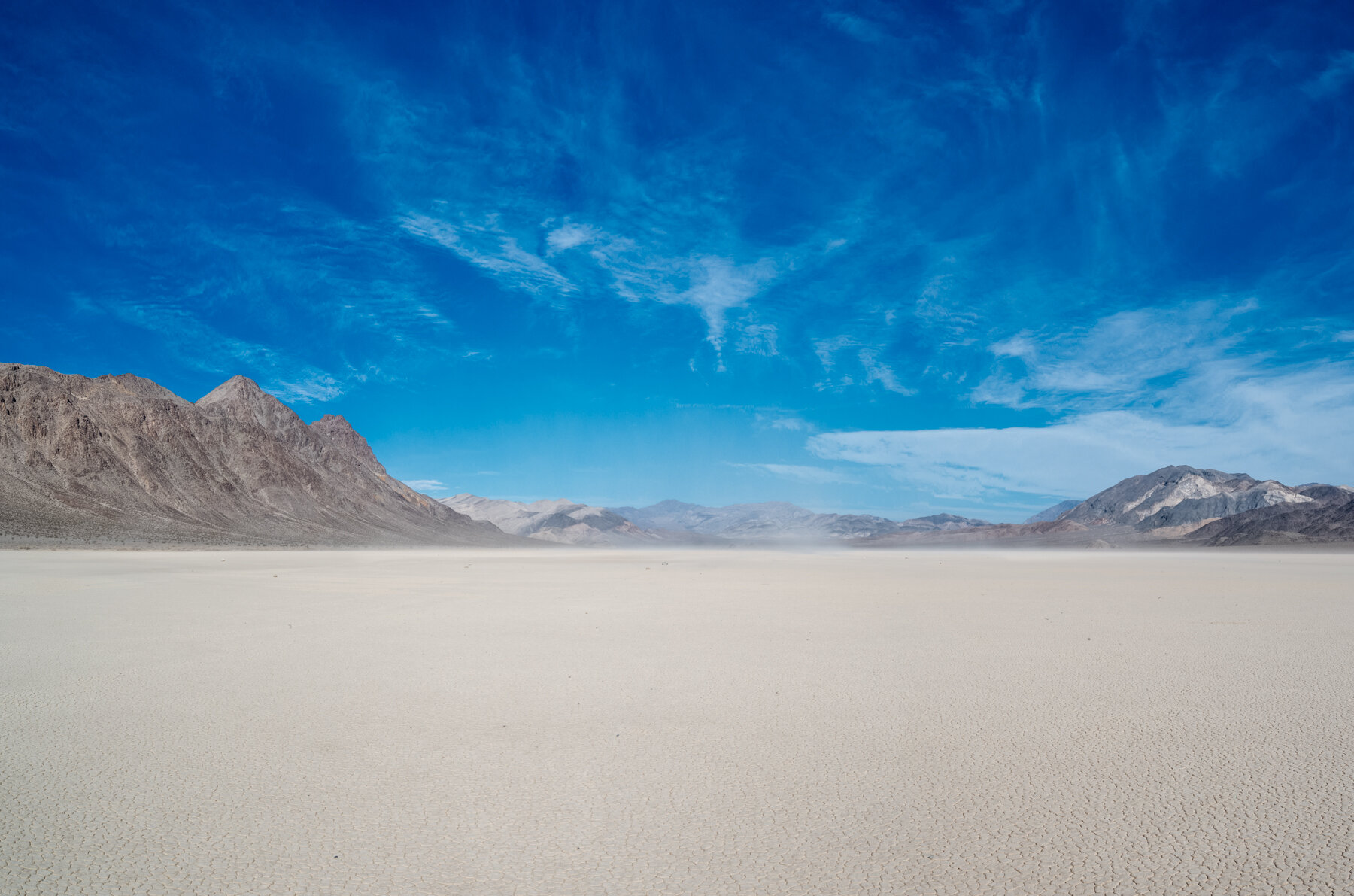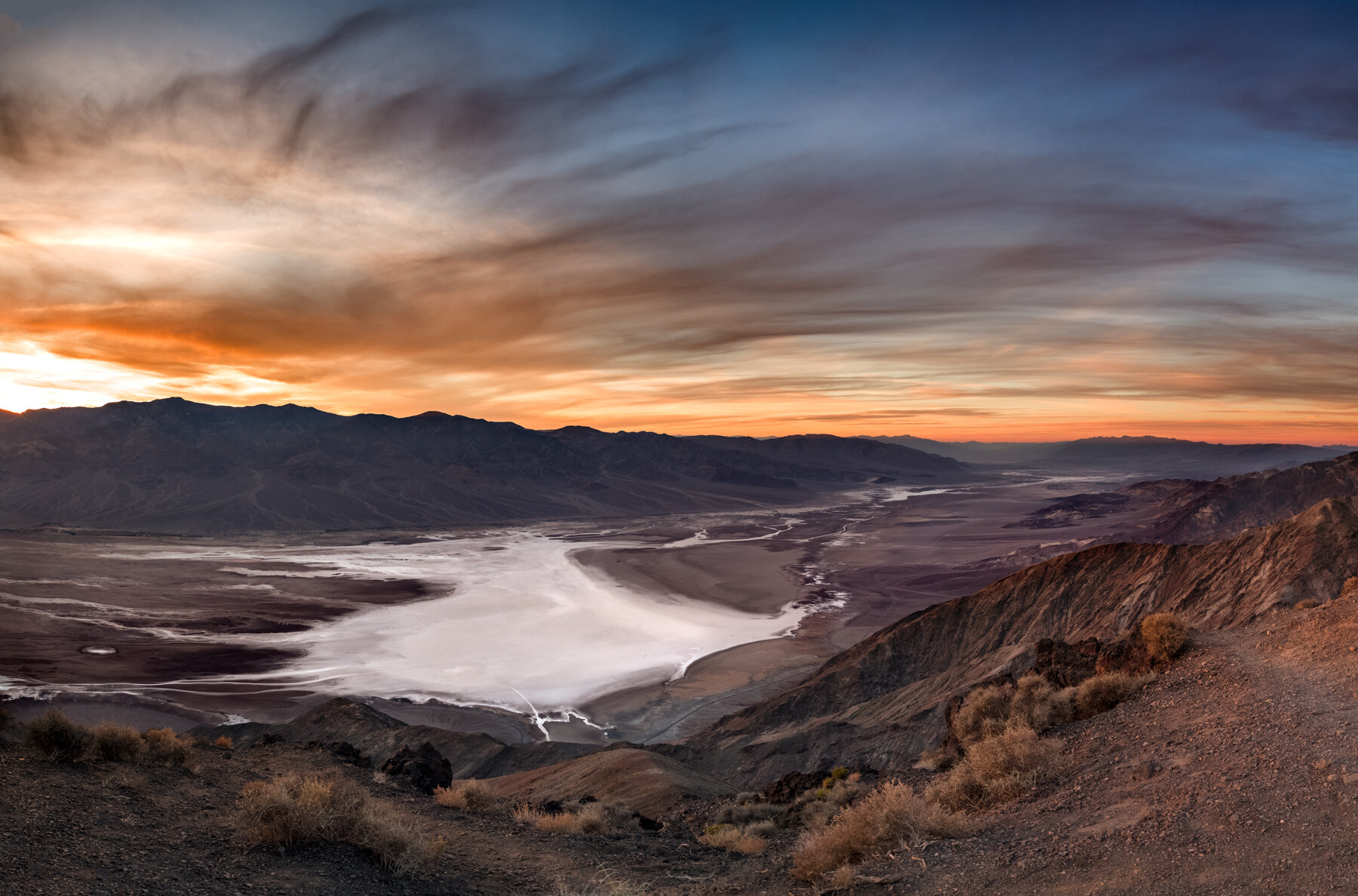Death Valley Panorama Heaven
Death Valley National Park was dedicated in 1933 by President Herbert Hoover and at 3.3 million acres (13,300 km2) is one of the largest in the Park Service. Straddling eastern California and western Nevada, Death Valley is home to a congeries of phantasmagoric sites: sandstone whipped into peaks by the wind, unearthly expanses of dry cracked salt pa
ns, mineral enriched hillsides that glow eerie neon colors, deep craters as if bombed out of the surface and soft undulating white dunes. Major sites including Zabriskie Point, Artist’s Palette, Dante’s Peak, Ubehebe Crater and the Racetrack draw exotic and eclectic crowds of tourists, geologists, meteorologists, photographers, painters, and movie makers – look around and you will find yourself not only on the set of innumerable Westerns but Star Wars as well.
Death Valley’s Badwater Basin is the central axis of the Park. It boasts the lowest point on the North American continent, 282 feet (86 m) below sea level. Summer temperatures regularly exceed 120 F, with the world record hitting 134 degrees F on June 10, 1913 at the aptly named town of Furnace Creek. Ruth and I visited in November 2017, when daytime temperature hovered at 70 degrees and at night time cooled down to the 40’s F. The air can vary from deathly still to violent gusts up to 80 mph.
Death Valley challenges the photographer: The park itself is enormous, the vistas expansive, the seemingly interminable valley is ringed by glorious mountains. Everything is rough and rugged. I found that the best way to capture both the essence and grandeur of the Park was with panorama photography.
I have used panorama photography over the past few years as an adjunct mode and found it most useful in grand landscape situations where the conventional one shot approach does not suffice. Death Valley is the perfect setting for panorama shooting.
Digital post processing has now made panorama photography an advanced form of photo-stitching in either Photoshop CC or Lightroom CC. Over the past decade it has rapidly evolved along with the technology, from a time consuming and error prone discipline to a relatively painless task. There are many didactic papers populating the Internet opining on related topics such as nodal points, manual versus auto-exposure and the advantages of tripods. These issues were important in the past when the photo-stitching technology was less developed and less forgiving, but with recent progress in the software, careful hand holding may be adequate, with the caveat that the tripod is mandatory in low light.
During a weeklong workshop in Death Valley I honed my skills at panoramas: First, I visualize the picture in my mind. Then, I plant my feet firmly and using any lens from wide angle to medium telephoto, I shoot holding the camera in the vertical position, carefully rotating my torso in a smooth circular fashion and I produce one exposure for every 15 degrees or so of rotation. The vertical position obviates excessive distortion and takes in more sky and foreground. I use either manual exposure, if the landscape in question is unevenly lit, or aperture control otherwise. I never use a polarizer, not even in balanced light, because it wreaks havoc on the sky. Most importantly, I always center the target carefully leaving ample border room, as the eventual photostitching is disastrous with tightly cropped images. Finally, I take at least two or three full passes, sequential photo shoots in the exact same spot, as I have discovered that even the slightest shift in position or change in technique results in significant alterations of the final panorama photograph. Hedge your bets and get extra shots!
"DEATH VALLEY CHALLENGESTHE PHOTOGRAPHER:THE PARK ITSELF IS ENORMOUS,THE VISTAS EXPANSIVE,THE SEEMINGLY INTERMINABLEVALLEY IS RINGED BY GLORIOUS MOUNTAINS.EVERYTHING IS ROUGH & RUGGED."
For processing, I have used the various iterations of both Photoshop CC and Lightroom CC since the inception of panoramas and have concluded that Lightroom CC is presently equivalent to Photoshop CC. Hence, for simplicity, I only use Lightroom CC: The pictures are batched and CTRL-M starts the process. There are three possible previews:
spherical, cylindrical and perspective. For most panorama photographs, spherical or cylindrical are fine. However, I activate Auto Select Projection allowing Lightroom to select the best option. Nonetheless, I usually check the other two potential previews before committing to the final process and have sometimes been surprised by the beauty of other views. As the software and technology have improved the surprises have been fewer. I never select auto-crop, as I will finish the panorama in Lightroom CC with Transform or in Photoshop with Cloning, Free Transform, Content Aware Fill or Content Aware Scale. Finally, for the second or third iterations of the photograph, I speed up the processing by starting with SHIFT+CTRL+M thus bypassing the preview stage. A nice shortcut and time-saver!
I then review the various versions of the panorama image, select my favorite and finish processing. Again, I cannot stress how varied the final panorama files can be from essentially the same baseline shots and ascribe this to the inherent quirks of the proprietary Photoshop CC and Lightroom CC algorithms. The panorama files emanating from my Leica S (Typ 007) are monstrous and require a powerful computer: the latest Mac Pro laptops are up to the task!
Finally, I stack my panorama TIF file on top of all the stitched files and save them in my archives knowing that they can be reworked in the future as the algorithms improve in time. Panorama photography can be readily mastered but requires planning, diligent practice and, at first infinite patience. Once perfected, it becomes another potent arrow in your photographic quiver. It transported me out of Death Valley into Panorama Heaven!







